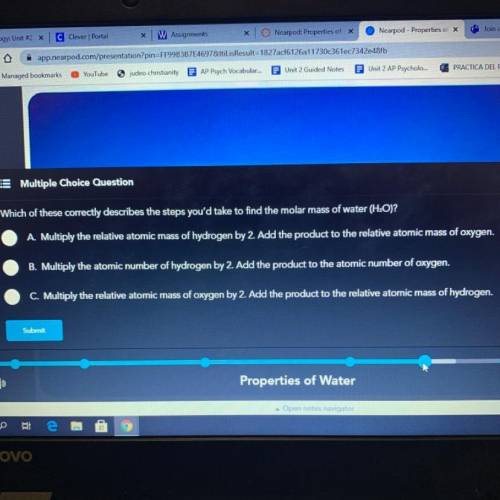
Which of these correctly describes the steps you'd take to find the molar mass of water (H:O)?
A. Multiply the relative atomic mass of hydrogen by 2. Add the product to the relative atomic mass of oxygen.
B. Multiply the atomic number of hydrogen by 2. Add the product to the atomic number of oxygen.
C. Multiply the relative atomic mass of oxygen by 2. Add the product to the relative atomic mass of hydrogen.


Answers: 3
Other questions on the subject: Biology

Biology, 21.06.2019 21:00, cascyrio2002
If a robot fixed another robot is it a engineer or doctor?
Answers: 2

Biology, 22.06.2019 00:30, BreBreDoeCCx
Imagine that certain laws of physics could be ignored and you were able to travel vast distances in moments. now imagine that you traveled to an earth-like planet located light-years away that is known to support life. think about what you’ve learned in this unit and make an argument for what you think would be the dominant type of life form on this planet. consider whether a notochord is required for an organism to manipulate its environment and become a dominant creature.
Answers: 3

Biology, 22.06.2019 03:00, seahorse0
To answer this question, researchers studied populations of the dusky salamander (desmognathus ochrophaeus) living on different mountain ranges in the southern appalachian mountains. the researchers tested the reproductive isolation of pairs of salamander populations by leaving one male and one female together and later checking the females for the presence of sperm. four mating combinations were tested for each pair of populations (a and b)—two within the same population (female a with male a and female b with male b) and two between populations (female a with male b and female b with male a). the proportion of successful matings for each mating combination was measured. for example, when all the matings of a particular combination were successful, the researchers gave it a value of 1; when none of the matings were successful, they gave it a value of 0. then the researchers calculated an index of reproductive isolation that ranged from 0 (no isolation) to 2 (full isolation). the reproductive isolation value for two populations is the sum of the proportion of successful matings of each type within populations (aa + bb) minus the sum of the proportion of successful matings of each type between populations (ab + ba). the table provides data for the geographic distances and reproductive isolation values for 27 pairs of dusky salamander populations.
Answers: 1

Do you know the correct answer?
Which of these correctly describes the steps you'd take to find the molar mass of water (H:O)?
A. M...
Questions in other subjects:

History, 10.06.2020 23:57



Chemistry, 10.06.2020 23:57

Mathematics, 10.06.2020 23:57

Mathematics, 10.06.2020 23:57

Physics, 10.06.2020 23:57

Mathematics, 10.06.2020 23:57








